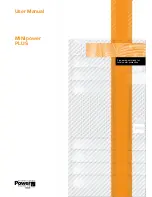
UNI EN ISO 9001-2015 n° 9115.BRMO
USER MANUAL
“Aquarius Plus”
File name
Date
Page
Code
PUT9I001 PUT9I1K5
DF19009A
05/04/19
6
di
32
PUT9I002
PUT9I003
MD03006C
- All rights are reserved according to the law. Reproducing or distributing this document to third parties without permission is prohibited.
battery. In this case the group does not switch on to supply loads until the voltage and frequency of
the main source fall within the allowed ranges.
11.
When there is no power supply, the UPS can be started by battery. This feature is called cold start
and is used to supply loads in emergencies. This feature can also be activated at full load.
12.
The UPS intervenes to protect the load when the following events occur: When the main input or
output power is too high or too low, in case of overload, short circuit, high inverter stage
temperature, minimum voltage and battery overload.
13.
The UPS can be installed in a Rack or Tower version. The viewing angle of the display can be easily
changed by pressing two buttons on the control panel of the apparatus. The content displayed on
the interface is rich in measurements. Alarms and statuses are easily controlled from the operator
panel.
14.
It is possible to connect the UPS to a computer, through an RS232 serial port. A software must be
installed on the PC that allows the intelligent management of most of the functionalities of the
device.
15.
If you want to connect the UPS to a computer network, you must have a kit called "SNMP adapter".
The connection can be internal or external to the UPS. Through these cards it is possible to monitor
the UPS from the internet or by evicting the various network protocols made available to the kit.
16.
A further possibility to monitor the UPS is the USB port, present on the UPS. Also, in this case it will
be necessary to load a software on the PC to which the group is connected.
17.
The ECO function saves electricity. When the input voltage is in an acceptable range, the load is fed
directly from the mains. In this case the inverter remains in stand-by. When the input voltage
comes out of the ranges, the load is powered by the inverter, which returns the output voltage in
the allowed ranges.







































